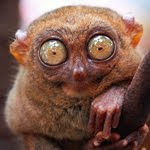
Francis Bacon, Study of Isabel Rawsthorne, 1966
Oil on canvas, 35.5 x 30.5 cm
Musée National d'Art Moderne, Centre Georges Pompidou, Paris
"There is no excellent beauty that hath not some strangeness in the proportion."
Sir Francis Bacon (1561–1626), "Of Beauty," Essays.
Margarita Cappock, Francis Bacon's Studio, Merrell, 2005. "Francis Bacon (1909-1992) is widely regarded as one of the most significant post-war painters. From 1961, his studio at 7 Reece Mews, South Kensington, London, was both his home and his workplace, and, over time, the repository of thousands of items that were central to his art, the impetus for many of his most important paintings. The studio - with its extraordinarily rich contents untouched since Bacon's death - was donated in 1998 by John Edwards to Dublin City Gallery The Hugh Lane, where, after meticulous dismantling and reconstruction by archaeologists, conservators and curators, it is now on permanent display. The studio's deconstruction revealed some 7500 objects, among them numerous well-thumbed, folded and torn photographs, many depicting Bacon's friends and lovers; illustrated publications, including books and magazine articles on subjects as diverse as medicine, sport, wildlife and war; drawings, interventions and handwritten notes by Bacon; slashed canvases and his final, unfinished work; and a welter of artist's materials - the walls themselves are vivid with encrusted paint, mixed and tested by Bacon. In Francis Bacon's Studio, Margarita Cappock provides the first in-depth study of the studio, selecting key elements from the dense mass of objects Bacon accumulated and placing them succinctly within the context of the artist's life and practice "(book jacket).
Savannah Schroll. "It could be said that entering an artist's studio is not unlike stepping into the artist's mind, as evidence of creative preoccupations is everywhere. Cappock's book, written to document the 1998 move of Bacon's studio from 7 Reece Mews in South Kensington, London, to the Hugh Lane Gallery in Dublin, provides a comprehensive record of the painstaking conservation process and an exploration of Bacon's painted and paperbound accretions. Sifting through a veritable heap of creative detritus, Cappock offers trenchant observations on Bacon's methods, habits, and interests and pieces together a story more illuminating than could be gleaned from Bacon's artistic statements alone. Most important, the material mined from tottering studio piles is applied directly to Bacon's body of work, and many significant connections are made. Cappock also unearths contact sheets from photo shoots that Bacon himself commissioned and locates in these photos the exact folds and tears transcribed in his paintings as visual or physiological distortions. The first book to provide such a thoroughgoing and insightful investigation of Bacon's creative space and source archive, this is strongly recommended for modern and contemporary art collections."

Bacon, Study for Head of Isabel Rawsthorne, 1967.
Jennifer Silverman, Francis Bacon: Order, Chance and the Abject Body, VDM Verlag, 2010. This examination looks at the work of British painter Francis Bacon (1909-1992) and his desire to portray sensation through the human figure. Bacon's use of the figure put him at odds with the art movements of his time. While he often vocalized his dislike of the Abstract Expressionists' work, he also utilized some of their techniques, relying on "free marks" to make his work more spontaneous. French philosopher Deleuze wrote extensively of Bacon's methods and use of "free marks" in his work Francis Bacon and the Logic of Sensation. In creating figures that teetered on the edge of abstraction, Bacon created a certain tension which he saw as a critical component to creating sensation in his work. In using the body this way, Bacon also crushed his figures, tearing them apart in order to allow the internal forces on the body out. Here, one can turn to the writing of Kristeva on the abject to gain a better understanding of why his figures inspire such horror. Although there has been much written on Bacon's figures, there has been no direct connection with Kristeva's theory of abjection, which sheds new light on the effect of his paintings on the viewer.






No comments:
Post a Comment